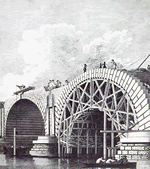Robert Mylne

- Blackfriars Bridge
- [click on the picture to enlarge it]
Robert Mylne (1733-1811) belonged to an old family of Edinburgh masons. After being a carpenter’s apprentice there, Mylne decided to acquire an architect’s education by studying in Italy. He trained more than four years in Rome (1755-59), where he won a medal for architecture at St Luke’s Academy. He formed a friendship with Piranesi and imbibed Carlo Lodoli’s functionalist architectural theories. Mylne also went to Sicily where he drew the ancient temples, but he was unable to have them published.
Soon after returning to England in 1759, he took part in the competition for the construction of Blackfriars Bridge in London. Boldly enough, he published Observations on Bridge Building (1760), a violent tract severely criticising the designs of his competitors, though they were more famous and experienced than himself, such as William Chambers, George Dance the Elder and Isaac Ware. Unexpectedly, Mylne’s design was the one selected, and he could bring to completion the building of the work, in which novelty was allied to elegance. Inaugurated in 1769 (and replaced a century later), the bridge consisted of only nine arches (in contrast with the twelve arches of Westminster Bridge), and it was decorated with paired ionic columns on each pier. Mylne asked his friend Piranesi to make an etching from a drawing of a view by the architect.
This masterstroke turned Mylne into a much sought-after architect for public buildings dependent on waterways, especially bridges, canals and harbours. Among others, he built the new bridge on the Tyne at Newcastle in 1775, and he competed for the rebuilding of London Bridge in 1800. Though he was fairly successful in the construction of country houses, especially in Shropshire and in Scotland, Mylne saw himself more as an architectural engineer than as an artist. He was one of the lights of the Society of Civil Engineers founded in 1771.
Mylne was less active in his native city, Edinburgh, where the recently restored concert room of St Cecilia’s Hall (1761-63) can still be seen. In London, he designed a few public and private buildings, such as the aristocratic club Almack’s (1764-65) and a hospital, the City Lying-In Hospital (1770-73), both destroyed. The exteriors of Mylne’s buildings are notable for their relative austerity, sometimes heralding the grand neoclassical style of architects such as Dance or Soane. His interior decoration, on the other hand, are close to the style of the Adam brothers.

